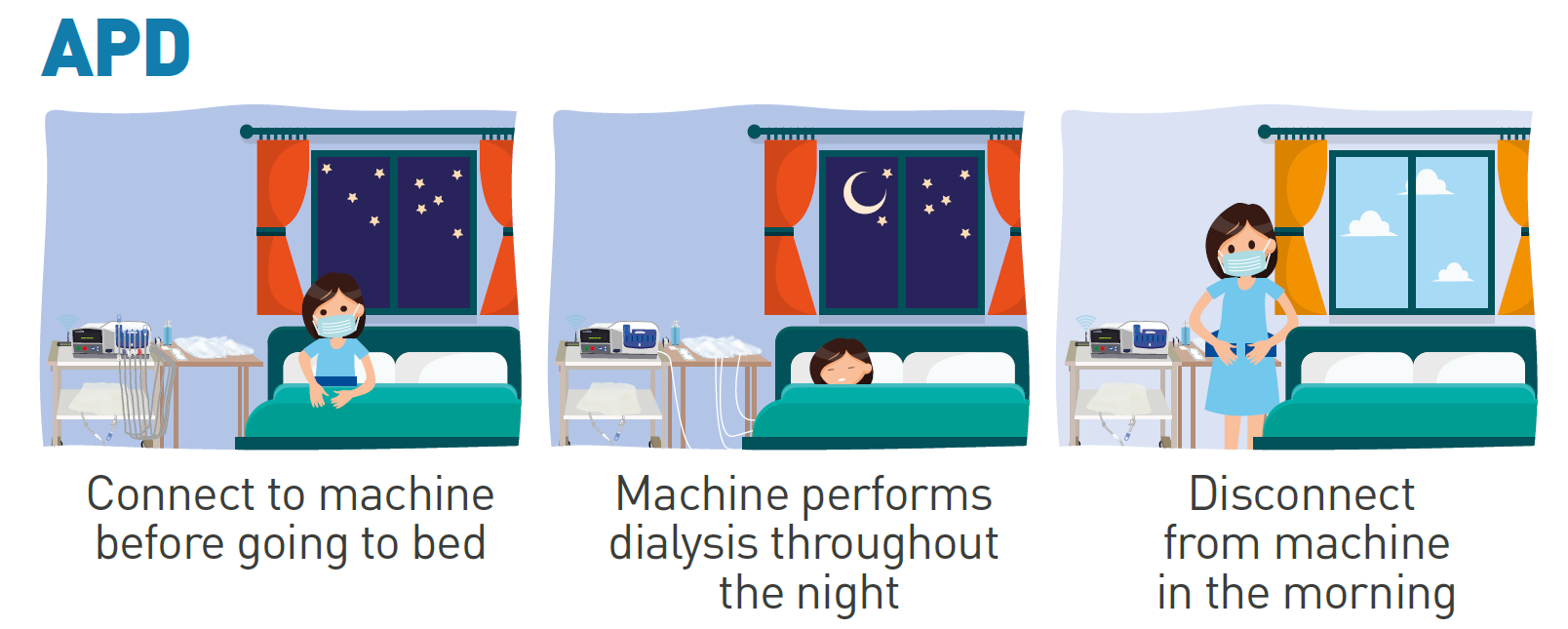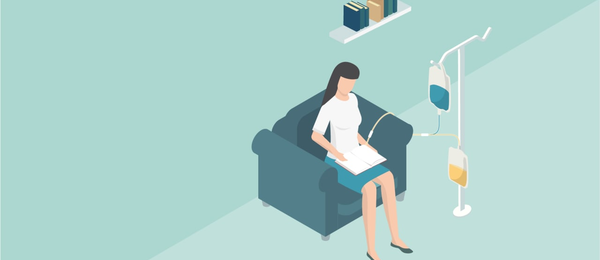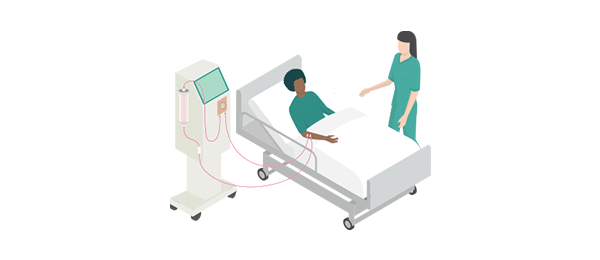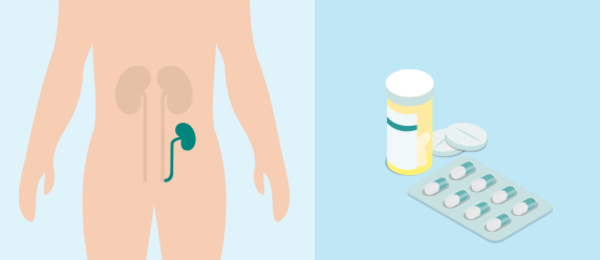Automated Peritoneal Dialysis (APD)
What is Automated Peritoneal Dialysis?
Peritoneal dialysis (PD) is the preferred treatment for end-stage renal diseases under the Peritoneal Dialysis First Policy, which has been implemented in Hong Kong since year 1985.1
Automated PD (APD) is a type of PD that is performed using a dialysis machine, which helps to deliver and drain the dialysate automatically/with the least human intervention. This dialysis machine, also called a cycler, is programmed to provide the exact amount of dialysis prescribed by your clinician.
How does PD work?
During peritoneal dialysis (PD), a dialysis solution (or dialysate) passes into your abdomen through a catheter. Once the dialysis fluid has flowed into your abdomen, it cleans your blood by absorbing any waste and excess fluid. This happens by osmosis and diffusion – which allows the waste and fluid to be transferred from your blood into the dialysis solution. After 1 to 4 hours, the dialysis solution containing the waste and excess fluid from your body is drained out of your abdomen through your catheter. This whole process is called an exchange.
Live Empowered with Automated Peritoneal Dialysis
Discover how a kidney failure patient embarks on his dialysis journey with PD and lives his life to the fullest with PD technology that is available in Hong Kong.
Click here to discover more patient stories
FAQ
For those who have already been prescribed APD therapy by your healthcare professionals, before you start the APD therapy at home, there are only a few requirements and preparations needed for a portable size of APD cycler. If you need to seek for any supports, you may contact dialysis service provider’s 24/7 APD helpline via phone call or whatsapp.
Preparing your home environment
The APD cycler is designed to suit most of Hong Kong’s household environments. You don’t need to spare a lot of space to store the cycler. You will need some storage space for your PD supplies.
The APD cycler should be placed on a stable, clean & flat surface (e.g. a table or trolley) with two electrical outlets nearby for the operation of both the cycler and modem. The modem will allow treatment data transmission to the cloud base remote patient management platform automatically, so that your healthcare team is able to identify problems and intervene early, which can help avoid unplanned hospital/clinic visit.
A best practice is to ensure that the door and windows are closed, and the fan switched off, when connecting and disconnecting your PD catheter during APD. This helps to prevent dust from entering the peritoneum. Learn more about peritonitis here.
Preparing APD Accessories
Your healthcare team may advise you on the additional accessories that would facilitate your APD treatment. Respective information will be shared before your in-hospital training session so that you can start your APD treatment smoothly.
Before each treatment, your APD cycler is set up with tubing that connects it to 10-15 litres of clean dialysis solution. A cycler tube is then connected to your catheter. The APD cycler is programmed to control the movement of clean dialysis solution into your abdomen by the machine.
It drains the used dialysis solution from your body and replaces it with new solution at regular intervals throughout the therapy. You will have to set up the dialysis machine with fresh equipment and dialysis fluid every time you do your APD therapy. Every patient is different and your APD cycler’s programme will be customised to your specific needs.

Lowering the chances of oedema2
APD is better to achieve ultrafiltration targets in particular type of patients (eg. high transporters of the peritoneum membrane)
APD has a lower risk of infections vs CAPD2
APD implementation requires only ONE manoeuvres (connections + disconnections) compared to CAPD (3-5 times per day) which can significantly reduce the incidence of peritonitis.
Lowering your discomfort during daytime3
Intraperitoneal pressure in APD could be 50% lower with the patient in supine position compared with CAPD.
Superior quality of life compared to CAPD3
APD is performed during your sleep at night, you are having more flexible daytime.
Also, over 60% of patients on APD could be employed full-time compared to those on CAPD, so that you could continue to be your family's financial support.
Remote Patient Monitoring (RPM) allows physicians to improve the tailoring of APD prescriptions4
Physicians are able to identify problems and intervene earlier, which can help avoid your unplanned visits to the hospital/clinic
APD is the ideal PD modality in children and elderly5
In the elderly, APD requires fewer connections, significantly saving time for the caregiver or caregiver could keep their original work in the daytime.
APD allows treatment individualisation according to age, body size, and metabolic needs of the developing child.
Children had a lower incidence of peritonitis with APD compared to CAPD.
- It will take time to get used to the feeling of performing PD. You may experience some physical symptoms, such as fullness in your abdomen, when you begin your treatments. However, as APD is performed while you are lying down, it may feel more comfortable than CAPD.
- Like with CAPD, you will have to follow the same important precautions to avoid the risk of infection. This will be taught by your healthcare team.
- If you are not able or confident enough to perform the dialysis, a member from your family could learn together with you and support your therapy. With APD, which can be performed during sleep, this would have less impact on your caregiver’s work/schedule.
There are 3 different funding models to support APD in Hong Kong:
Hong Kong Kidney Foundation APD Programme5
A patient who is a Hong Kong Citizen can consider applying for either one of the APD programs owned by Hong Kong Kidney Foundation (HKKF).
HKKF is a non-profit making, voluntary organization. In 1997, they commenced a charitable program to support patients with some financial means opting for APD as a self-choice option with the “on-loan” of an APD machine. In 2020, HKKF launched the “Co-Fund Co-Use” APD program to further support more patients.
Hospital Authority Home Dialysis Programme (Former Hong Kong Jockey Club Charitable Trust Programme)6
The programme was launched in 2009; your renal unit will refer you to the programme if you are suitable and provide the training and machine to you directly, so that you can perform home dialysis treatment overnight.
Self-financed Rental Program with Dialysis Service Provider
You could rent an APD cycler with your dialysis service provider directly. They have a flexible rental programme to support you at the initial stage, and you may consider applying to another charitable program in parallel.
For details of each programme, please consult the healthcare team or medical social worker in your renal centre or contact your dialysis service provider professional representative directly.
Discuss with your renal healthcare team during consultation if you would like to:
-
Participate in different day time activities, like study, work or social gathering with your friends and family.
-
Look for a dialysis option that has minimal impact to you and your caregiver’s daily schedule.
-
Look for a dialysis option gives more flexibility in the day, fewer bags exchange, and a better quality of life.
Your renal healthcare team may further perform a basic assessment with you and introduce you to how to further process till your training date.
Next Steps: Support Available if You are Interested in APD
From your Renal Centre
Your renal centre would support you along your dialysis journey. Some of them may provide an enquiry hotline for you to dial in and seek clinical advice.
From Dialysis Service Provider
The dialysis service provider provides dialysis products and services and works closely with healthcare providers and patients to help PD patients stay strong and live well physically, psychologically, and mentally.
To let you and your caregiver undergo APD with a peace of mind, they provide diversified support, including:
Dedicated PD Nursing Team
To provide machine operation and troubleshoot training to you physically & enhanced virtually during COVID outbreak.
Series of Assisted Visual Aids (Both online and offline)
APD cycler operation and troubleshooting videos & quick start guide booklet are ready with QR code scanning for ease of access anytime anywhere.
Patient Education Talks & Campaigns
Continuously support you & your caregiver to Stay Strong with your APD therapy physically and virtually through education events.
24-Hour Helpline
Real-time support by professional healthcare workers to provide instant response to you during night-time home therapy.
Online PD Solution Ordering
Allow PD solution ordering anytime anywhere
Where to go next?

Continuous Ambulatory Peritoneal Dialysis (CAPD)
CAPD can be performed at work, home or during travel.

In-Centre Haemodialysis (In-Centre HD)
You may prefer to receive dialysis at a hospital or treatment centre near you with ICHD.

Kidney Transplant & Conservative Care
If you and your clinician decide dialysis isn’t right for you, there are other treatment options you may consider.